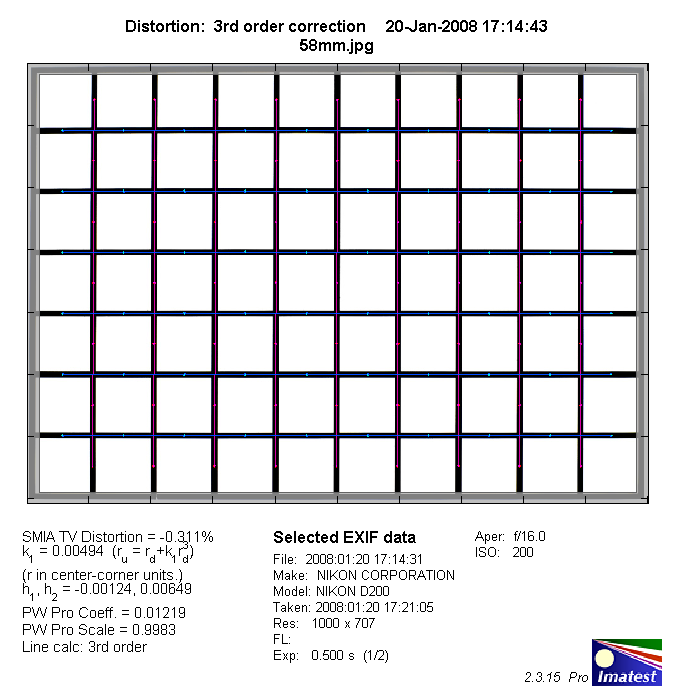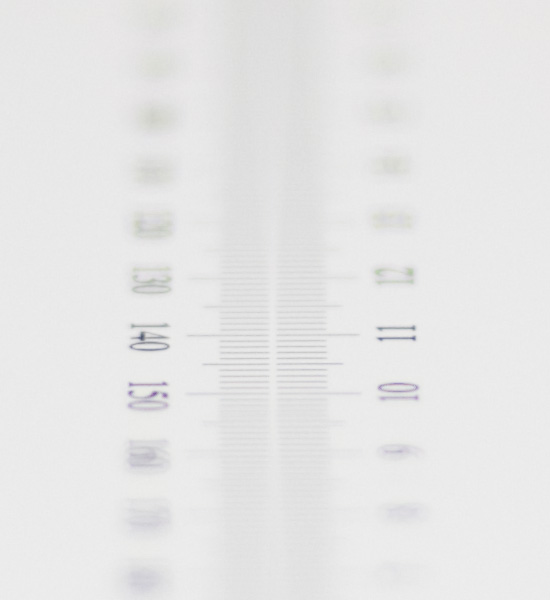|
Voigtlander Nokton 58mm f/1.4 SL II - Review / Test Report - Analysis |
|
Lens Reviews -
Nikon / Nikkor (APS-C)
|
|
Page 2 of 2
Distortion
The Nokton produces only a minor degree of barrel distortion (0.3%) which is usually nothing
to worry about in field conditions.

The chart above has a real-world size of about 120x80cm.
Vignetting
The 58mm f/1.4 is obviously an ultra-large aperture lens and as such it renders a bit of
vignetting at maximum aperture even when used on an APS-C DSLR. At f/1.4 we're talking about
0.7EV which may be visible at times. The problem is pretty much negligible from f/2 onwards though.

MTF (resolution)
The Nokton was able to produce good to superb resolution figures under lab conditions.
Unsurprisingly the lens shows the weakest performance at f/1.4 - the center resolution
is already very good here but the borders are soft. The overall contrast level is also
quite low at this setting which is actually a little disappointing regarding its
name - some may have associated "Nokton" with the famous Noct-Nikkor which is supposed
to produce great results straight from the max. aperture (less so at medium apertures).
Anyway, at f/2 the contrast increases and the borders recover to good level. A major
boost in quality occurs when stopping down to f/2.8. The peak performance is
reached by f/5.6 where the lens does probably exceed the resolution capabilities of
the 10mp sensor of the D200 (used for testing).
Please note that the MTF results are not directly comparable across the different systems!
Below is a simplified summary of the formal findings. The chart shows line widths per picture height (LW/PH) which can be taken as a measure for sharpness.
If you want to know more about the MTF50 figures you may check out the corresponding Imatest Explanations
Chromatic Aberrations (CAs)
Lateral Chromatic aberrations (color shadows at harsh contrast transitions) generally
well controlled and not overly field relevant at around 0.5px on the average at the image
borders.

Bokeh
The quality of the bokeh, the out-of-focus blur, is naturally of major interest for
an ultra-large aperture lens like the Nokton. The recently reviewed Voigtlander Ultron
40mm f/2 disappointed here but the Nokton does a better job albeit not a perfect one.
Out-of-focus highlights the Nokton shows a bit of an outlining effect at f/1.4
and f/2 but it's gone by f/2.8. At f/4 there're a few hints of a deteriorating circular
aperture shape but then f/4 is probably not really a mainstream setting in terms of bokeh.
The focus transitions around the in-focus point are quite smooth in this test scene but the
lens produced a less than optimal background blur.

You can download the full-size sample images here:
Longitudinal Chromatic Aberrations (LoCA)
LoCAs (non-coinciding focal planes of the various colors) are a further aspect. Similar to
most other ultra-large aperture lenses the Nokton has also some stakes here. As you can
notice below the halos have different colors - magenta (red + blue) in front the focus point
and green beyond. From a global perspective the LoCAs are well controlled for such
a lens. Truly "apochromatic" lenses don't show LoCAs but these lenses are very rare especially
below 100mm.
|
Move the mouse cursor over the f-stop marks below to observe the respective LoCAs
|
| f/1.4 |
f/2 |
f/2.8 |
f/4 |
|

|
Verdict
The Voigtlander Nokton 58mm f/1.4 SL II is an interesting new offer in the standard lens
arena. The slightly longer than average focal length is especially attractive for APS-C
DSLR users - a field-of-view "equivalent" to "85mm" is pretty much in the sweet spot of
portrait photography. Technically the lens is somewhat soft at f/1.4 both in terms of border
resolution as well as overall contrast. At f/2 and more so at f/2.8 the quality has improved
significantly and the quality of the bokeh is also best around these settings. The sheer
resolution potential in unleashed at medium aperture settings where the lens is about
as good as it gets today. The level of distortions is negligible in field conditions
and lateral CAs as well as vignetting are not much of an issue either. The lens is absolutely
beautifully crafted and a joy to use despite the lack of AF. Unfortunately the constant
overexposure of 2/3EV is a bit of a faux-pas although it's something you can deal with.
The lens is attractively priced at around 330US$/€ so if you've got a soft spot
for a more classical approach to photography (count me in ...) it may be reason enough to
favor it over the AF Nikkors and it's a viable alternative to the Zeiss T* 50mm f/1.4 ZF.
It is not a superior option though.
|